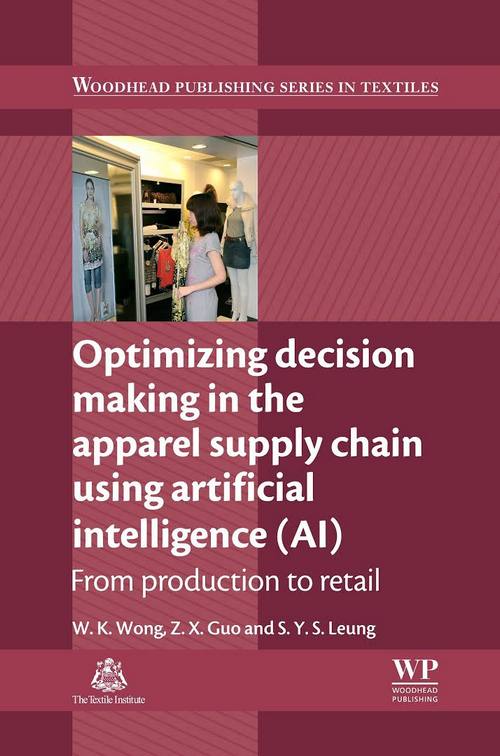
Contents
Woodhead Publishing Series in Textiles ix
Preface xvii
1 Understanding key decision points in the
apparel supply chain 1
W. K. W ONG , The Hong Kong Polytechnic University, China
1.1 Introduction 1
1.2 Selection of plant locations 1
1.3 Production scheduling and assembly line balancing control 2
1.4 Cutting room 3
1.5 Retailing 10
2 Fundamentals of artificial intelligence techniques for apparel management applications 13
Z. X. G UO , Sichuan University, China and W. K. W ONG ,
The Hong Kong Polytechnic University, China
2.1 Artificial intelligence (AI) techniques: a brief overview 13
2.2 Rule- based expert systems 17
2.3 Evolutionary optimization techniques 21
2.4 Feedforward neural networks (FNNs) 26
2.5 Fuzzy logic 32
2.6 Conclusions 38
2.7 References 39
3 Selecting the location of apparel manufacturing plants using neural networks 41
W. K. W ONG , X. H. Z ENG and K. F. A U , The Hong Kong
Polytechnic University, China
3.1 Introduction 41
3.2 Classification methods using artificial neural networks 42
3.3 Classifying decision models for the location of clothing plants 43
3.4 Classification using unsupervised artificial neural networks (ANN) 47
3.5 Classification using supervised ANN 49
3.6 Conclusion 52
3.7 Acknowledgements 53
3.8 References 53
3.9 Appendix: performance of back propagation (BP) and learning vector quantization (LVQ) with a different number of hidden neurons 54
4 Optimizing apparel production order planning scheduling using genetic algorithms 55
Z. X. G UO , Sichuan University, China and W. K. W ONG ,
S. Y. S. L EUNG , J. T. F AN and S. F. C HAN , The Hong Kong
Polytechnic University, China
4.1 Introduction 55
4.2 Problem formulation 57
4.3 Dealing with uncertain completion and start times 59
4.4 Genetic algorithms for order scheduling 61
4.5 Experimental results and discussion 66
4.6 Conclusions 74
4.7 Acknowledgement 74
4.8 References 74
4.9 Appendix 1: nomenclature 76
4.10 Appendix 2: Gantt charts 77
5 Optimizing cut order planning in apparel production using evolutionary strategies 81
W. K. W ONG and S. Y. S. L EUNG , The Hong Kong
Polytechnic University, China
5.1 Introduction 81
5.2 Formulation of the cut order planning (COP) decision- making model 87
5.3 Genetic COP optimization 90
5.4 An example of a genetic optimization model for COP 95
5.5 Conclusions 101
5.6 Acknowledgement 101
5.7 References 101
5.8 Appendix: comparison between industrial practice and proposed COP decision-making model 103
6 Optimizing marker planning in apparel production
using evolutionary strategies and neural networks 106
W. K. W ONG and X. X. W ANG , The Hong Kong Polytechnic
University, China and Z. X. G UO , Sichuan University, China
6.1 Introduction 106
6.2 Packing method for optimized marker packing 109
6.3 Evolutionary strategy (ES) for optimizing marker planning 116
6.4 Experiments to evaluate performance 123
6.5 Conclusion 128
6.6 Acknowledgement 129
6.7 References 129
7 Optimizing fabric spreading and cutting schedules in apparel production using genetic algorithms and fuzzy set theory 132
W. K. W ONG , C. K. K WONG , P. Y. M OK and W. H. I P ,
The Hong Kong Polytechnic University, China
7.1 Introduction 132
7.2 Problem formulation in fabric- cutting operations 135
7.3 Genetic optimization of fabric scheduling 138
7.4 Case studies using real production data 142
7.5 Conclusions 149
7.6 Acknowledgement 150
7.7 References 150
7.8 Appendix: nomenclature 151
8 Optimizing apparel production systems using genetic algorithms 153
W. K. W ONG , P. Y. M OK and S. Y. S. L EUNG , The Hong Kong
Polytechnic University, China
8.1 Introduction 153
8.2 Problem formulation in sewing operations 155
8.3 Genetic optimization of production line balancing 156
8.4 Experimental results 163
8.5 Conclusions 166
8.6 Acknowledgement 167
8.7 References 167
8.8 Appendix: nomenclature 168
9 Intelligent sales forecasting for fashion retailing using harmony search algorithms and extreme learning machines 170
W. K. W ONG , The Hong Kong Polytechnic University, China and
Z. X. G UO , Sichuan University, China
9.1 Introduction 170
9.2 Hybrid intelligent model for medium- term fashion sales forecasting 174
9.3 Evaluating model performance with real sales data 180
9.4 Experimental results and analysis 182
9.5 Assessing forecasting performance 190
9.6 Conclusions 193
9.7 Acknowledgement 194
9.8 References 194
10 Intelligent product cross- selling system in fashion retailing using radio frequency identifi cation (RFID) technology, fuzzy logic and rule- based expert system 196
W. K. W ONG and S. Y. S. L EUNG , The Hong Kong Polytechnic
University, China, Z. X. G UO , Sichuan University, China and
Z. H. Z ENG and P. Y. M OK , The Hong Kong
Polytechnic University, China
10.1 Introduction 196
10.2 Radio frequency identifi cation (RFID)-enabled smart dressing system (SDS) 200
10.3 Intelligent product cross- selling system (IPCS) 204
10.4 Implementation of the RFID-enabled SDS and IPCS 212
10.5 Evaluation of the RFID-enabled SDS 215
10.6 Assessing the use of RFID technology in fashion retailing 219
10.7 Conclusions 221
10.8 Acknowledgement 222
10.9 Notes 222
10.10 References 222
Index 225
